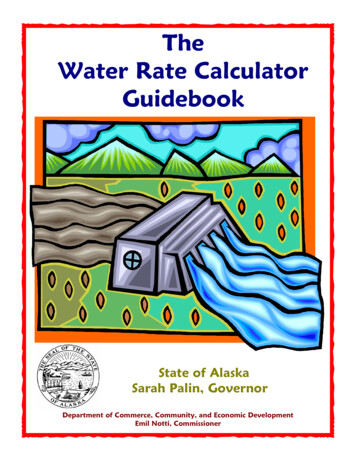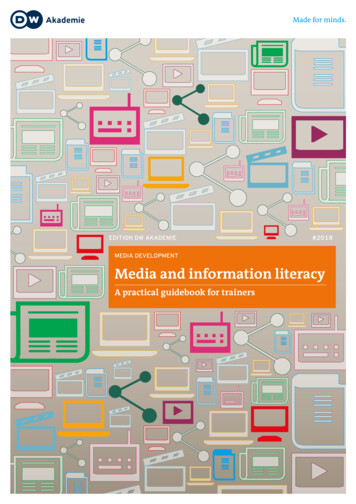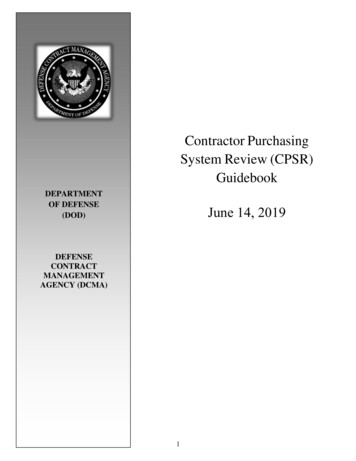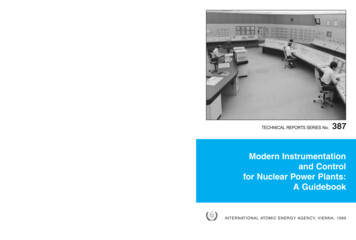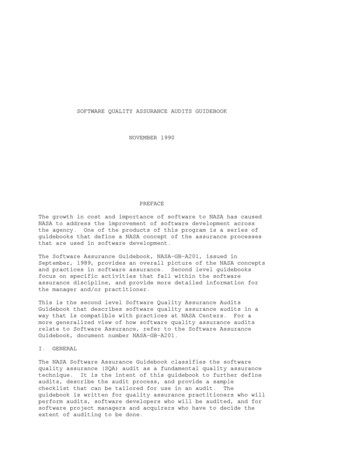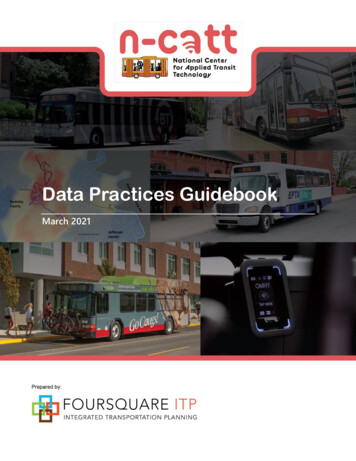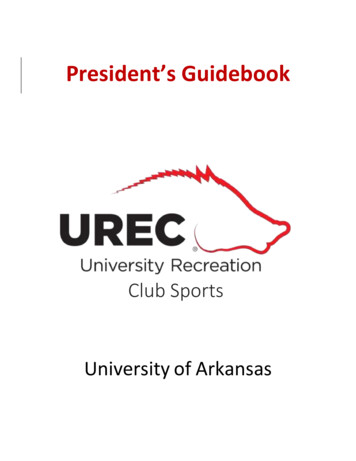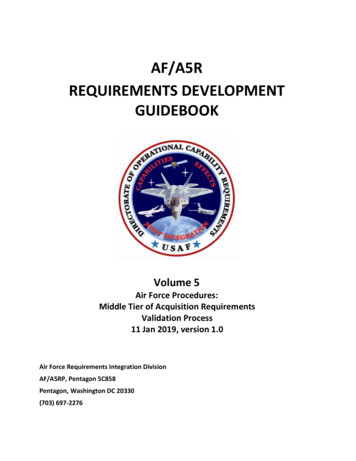
Transcription
AF/A5RREQUIREMENTS DEVELOPMENTGUIDEBOOKVolume 5Air Force Procedures:Middle Tier of Acquisition RequirementsValidation Process11 Jan 2019, version 1.0Air Force Requirements Integration DivisionAF/A5RP, Pentagon 5C858Pentagon, Washington DC 20330(703) 697-2276
2AF/A5R REQUIREMENTS DEVELOPMENT GUIDEBOOK, Volume 5PREFACEThis Guidebook is fifth in a series of AF/A5R developed guides describing Air Force Operational CapabilityRequirements Development. This guidebook describes the requirements actions that must be completedin support of all Middle-Tier of Acquisition efforts.There are no restrictions on release or distribution of this guidebook.This Guidebook is a “how to” guide for use by all stakeholders participating in the AF requirements process,and in some cases it includes the answer to the questions “why do we have to do it that way,” “where is thatwritten” and “where do we find additional information.”NOTE: The AF/A5R Requirements Development Guidebooks represent official guidance developed to ensurecompliance with, and implementation of, overarching Joint Capabilities Integration and DevelopmentSystem (JCIDS) and Acquisition policies. It is AF Policy (per AF/A5R direction and authority under HAF MissionDirective 1-56) that, to the maximum extent practical, AF Sponsors are expected to comply with the guidancedescribed in the A5R Guidebooks.If you have questions regarding specific information in the guidebook(s), or if you have suggestions forimprovements, please contact the OPR:OPR: Mr. Steve “Bulldog” Billingsley, 703-697-2276 (DSN 227)AF/A5RP Portal Page. Additional guidance and information, to supplement this Guidebook is located onthe AF Portal: To access the A5RP Requirements Portal Page go to https://www.my.af.mil Navigate to “Organizations A-Z”, then type in “A5RP”.
3AF/A5R REQUIREMENTS DEVELOPMENT GUIDEBOOK, Volume 5CHANGE SUMMARYChange SummaryInitial Release: Revised the Guidebook Volumes to align policy and guidance undernew Vol 1, as the “Capstone Guidebook” and separate the procedural guidance andother best practices in subsequent guidebook volumes and handbooks- Vol 1, Policy and Guidelines (revised previous Vol 1, refined all policy info)- Vol 2, Urgent Needs (major updates, revised the transition review portion)- Vol 3, JCIDS Deliberate Process (split out from Vol 1, reorganized layout)- Vol 4, Modification Proposals (split out from Vol 1, minor edits)Date3 Oct 2017Initial release of Vol 5, Middle Tier Rapid Acquisition Requirements ValidationProcess11 Jan 2019
4AF/A5R REQUIREMENTS DEVELOPMENT GUIDEBOOK, Volume 5TABLE OF CONTENTSSECTION 1. INTRODUCTION1.1. Overview and Background 41.2. Description .5SECTION 2. AF MIDDLE TIER OF ACQUISITION REQUIREMENTS PROCEDURES2.1. General 52.2. Process.52.3. Documentation .52.4. Staffing and Validation 62.5. Joint Interest Determination 62.6. Final Actions 72.7. Directed Middle Tier Acquisition Paths 7SECTION 3. DOCUMENTS3.1. JCIDS Document 73.3. Rapid Prototyping/Fielding Requirements Documents . 73.4. Rapid Prototyping Requirements Document . .83.5. Prototyping Analysis Report 93.6. Rapid Fielding Requirements Document .93.7. MTAR Memorandum . 11APPENDIX 1 - GLOSSARY OF REFERENCES AND SUPPORTING INFORMATION .12SECTION 1. INTRODUCTION1.1Overview and Background. This section outlines the requirements validation activities that support theMiddle Tier of Acquisition process. The Middle Tier Requirements and Acquisition processes areoptimized to advance Air Force capabilities against the challenges outlined in the National DefenseStrategy (NDS) at a faster pace than the deliberate acquisition processes. The Middle Tier Requirementsand Acquisition processes and timelines must align in order to: Adapt to developing threats as outlined in the NDS and Chairman's Net Assessment andNational Air and Space Intelligence Center assessments Fully leverage advancing technologies from industry, allies, and sister Services Fully leverage additional authorities to prototype and experiment to learn, adapt andadvance key technologies and capabilities
5AF/A5R REQUIREMENTS DEVELOPMENT GUIDEBOOK, Volume 51.2. Description. Section 804 of the National Defense Authorization Act (NDAA) for Fiscal Year 2016(Public Law 114-92), provides authority to the Department of Defense (DoD) to rapidly prototypeand/or rapidly field capabilities under a new pathway, distinct from the deliberate acquisitionsystem.Under the Middle Tier of Acquisition, programs subject to the guidance shall not be subject tothe JCIDS Manual and DoD Directive 5000.01, "The Defense Acquisition System," except to theextent specifically provided in the implementing guidance. Middle Tier of Acquisition is definedas a rapid acquisition approach that focuses on delivering capability in a period of 2 to 5 years.For rapid prototyping, innovative technology will be used to rapidly develop fieldable prototypes todemonstrate new capabilities and meet emerging military needs. The objectives are: (1) field aprototype that can be demonstrated in an operational environment, and (2) provide a residualoperational capability within 5 years of contract award.For rapid fielding, proven technologies will be used to field production quantities of new or upgradedsystems with minimal development required. The objectives are: (1) begin production within 6months, and (2) complete fielding within 5 years of contract award.SECTION 2. AF MIDDLE TIER OF ACQUISITION REQUIREMENTS PROCEDURES2.1General. The Rapid Acquisition Requirements process is based on the JCIDS in that it requires analysisto determine the most effective materiel or non-materiel solution based on a valid threat assessmentor approved capability gap(s) and it requires proper documentation to deliver capability solutions tothe warfighter quickly.2.2Process. By default, all new capability development efforts will be reviewed for Middle-Tier ofAcquisition applicability for non-developmental capabilities that can be prototyped and fielded withinthe 6 month to 5 year timeframe. The first step is to ensure that the new capability falls within theguidelines of the annual Capability Development Guidance (CDG). The sponsor (LeadCommand/Agent, MAJCOM or Headquarters Air Force (HAF) 2-letter as appointed by AF/A5)coordinates with AF/A5R to review all previously-accomplished analyses and documentation insupport of the new effort using the Information Resource Support System (IRSS) database or otherrelated methods. Once it is determined that adequate analysis has been completed, the sponsorprovides a presentation to AF/A5R that describes how the new Middle-Tier of Acquisition effort fitswithin an overall Capability Development Strategy (CDS). The purpose of the CDS is to define theoverall plan of action and milestones that will produce a materiel solution, and it may includeincremental paths incorporating various processes including Middle-Tier of Acquisition, deliberateprocess, information systems, modifications to fielded systems (AF Form 1067), and DOTmLPFchanges. The CDS will include priorities and tradeoffs, and it will be informed by available resourcesin coordination with AF/A8P to determine if funding is available for the new effort. If an applicableCDS does not exist, the sponsor will explain how the new capability fits within the approved CDG.Once AF/A5R approves the path ahead, the sponsor will write a Rapid Prototyping RequirementsDocument (RPRD) or a Rapid Fielding Requirements Document (RFRD) for staffing and validation.2.3Documentation. Following AF/A5R approval of the analysis and development of the CDS, the Sponsorbegins development of a requirements document to support Middle Tier of Acquisition. Sponsors havethe option to use a validated Initial Capability Document (ICD), Draft Capability Development Documentor a Capability Development Document (CDD) to transition into the Middle Tier of Acquisition process,or they can create a RPRD or a RFRD if no validated JCIDS document exists.
62.42.5AF/A5R REQUIREMENTS DEVELOPMENT GUIDEBOOK, Volume 5Staffing and Validation. Upon approval by the MAJCOM/Agency Commander, the sponsor willsubmit either a RPRD or a RFRD for staffing and comment adjudication. The 10 day staffing periodwill be conducted at the HAF general officer level. During the staffing process, the SAF/AQ SeniorAcquisition Executive (SAE) determines if the new capability development effort should continue inthe Middle Tier of Acquisition process or move to the deliberate process. Following the 10-daystaffing period, the sponsor will have 14 days to complete comment adjudication and submit a finaldocument in IRSS to AF/A5RP. AF/A5RP will prepare a staff package that will be submitted for AFvalidation. Note: Both prototyping and fielding documents will be presented to the Milestone DecisionAuthority (MDA) for approval to continue in the Middle -Tier of Acquisition process. Note: If not approved for Middle -Tier of Acquisition by the SAF/AQ SAE, the sponsor willtransition to the deliberate process.Joint Interest Determination. Once the sponsor has submitted the document, AF/A5RP will preparethe document for HAF staffing. Simultaneously, AF/A5RP will forward the document to the J8Gatekeeper for Joint Staff awareness. Should Joint Staff determine that Joint Interest exists, the AirForce will proceed with fielding activities to preserve the five-year fielding limitation outlined in the
7AF/A5R REQUIREMENTS DEVELOPMENT GUIDEBOOK, Volume 5FY16 NDAA Middle Tier of Acquisitions guidance while Joint Interests are outlined and a Jointapproach is developed, if required.2.6Final Actions. Following validation by the appropriate Requirements Decision Authority, AF/A5RP willupload the approved document to IRSS and forward it to the sponsor and the appropriate SAF/AQoffice to proceed with the prototyping or fielding phase.2.7Directed Middle Tier of Acquisition Paths. In situations where the use of the FY16 NDAA Section 804authorities are directed by the SAE or the Milestone Decision Authority (MDA) (i.e., not initiated bythe sponsor and coordinated through AF/A5R), AF/A5R will determine a capability sponsor and willformally assign the sponsor in a memorandum. The sponsor will establish a partnership with AF/A5Rand AF/A5A to initiate the process outlined in Sections 2.2 through 2.6.SECTION 3. DOCUMENTS3.1JCIDS Documents. For prototyping efforts, the sponsor may submit a previously-validated ICD, draftCDD or CDD. If the JCIDS document is current and requires no updating, the sponsor will submit theJCIDS document to AF/A5R for review and approval for use based on the latest CDG. Once approved,the sponsor submits the JCIDS document directly to SAF/AQX with a Middle Tier of AcquisitionRequirements Memorandum (MTARM) attached explaining why the new capability is a goodcandidate for the Middle -Tier of Acquisition process. Once prototyping is complete, the sponsor willtransition from the JCIDS document to an RFRD using the new information obtained from theprototyping effort. 3.2For fielding efforts when the sponsor has a validated JCIDS document, the sponsor may submit acurrent CDD or a CDD Update to AF/A5R for review and approval for use based on the latest CDG.Once approved, the sponsor submits the JCIDS document directly to SAF/AQX, with an MTARMattached, explaining why the new capability is a good candidate for the Middle Tier of Acquisitionprocess. 3.3Note: For multiple prototyping efforts, multiple prototyping documents will be needed.Note: See Section 3.7 for the MTARM template.Note: Sponsor must ensure that funding within the FYDP is still available.Rapid Prototyping/Fielding Requirements Documents. If a previously-validated JCIDS document doesnot exist, a sponsor can create an RPRD or an RFRD. The sections in the Middle Tier of AcquisitionsRequirements Documents are based on the JCIDS CDD. Sponsors will use the most current JCIDSmanual as a guide to write each section of the RPRD or RFRD.
83.4AF/A5R REQUIREMENTS DEVELOPMENT GUIDEBOOK, Volume 5Rapid Prototyping Requirements Document. Below is the format for the RPRD. The RPRD is similar toa draft CDD. Sponsors must use the CDD format found in the current JCIDS Manual (31 Aug 2018) tocreate each section of the RPRD.Cover Page: Classification Title starting with the phrase “Rapid Prototyping Requirements Document for ” Sponsoring organization and signature authority who authorized the submittal for review. TheSponsor GO/FO must endorse the RPRD and the RFRD Date submitted by the sponsoring organization Proposed MDA Proposed Joint Staffing Designator (JSD) Proposed Joint Performance Requirement (JPR) Proposed Acquisition Category (ACAT) Document revision number Primary and secondary POCs for the document sponsor. Include name, title/rank, phone andboth NIPRNET and SIPRNET email addresses. Proposed validation authorityValidation Page:Commander’s Intent: Commander’s explanation of why this effort is a candidate for rapid prototyping. Briefly discussthe 6 month to 5 year fielding schedule. Commander’s description and definition of what the successful fielding and implementation ofthis new materiel solution will look like. Operational scenario.Note: The Commander’s Intent must be signed by the MAJCOM/Agency Commander. Document Body:Section 1: Operational Context. Provide operational context explaining how the capability solution contributes to themissions and activities of the Air Force. Detail the capability gaps to be filled and their priority to the Air Force.Section 2: Capability Discussion. Summarize any/all related analyses or studies conducted to derive the performanceattributes. For IT systems, add the IT box construct.Section 3: Program Summary. Summarize the overall program strategy for reaching IOC and FOC.
9AF/A5R REQUIREMENTS DEVELOPMENT GUIDEBOOK, Volume 5Section 4: Attributes. Explain why the capability requirements are essential to achieve assigned goals andobjectives. Initial objective values should be the value necessary to achieve mission objectives withmoderate operational risk.Section 5: Other System Attributes. Define other system attributes (if known).Section 6: Joint Interoperability (as required). Specify how the system will operate within the Joint environment.Section 7: Technology/Manufacturing Readiness. Discuss technology and manufacturing readiness.Architecture Products (determined by the Program manager).Note: Similar to a Draft CDD, the RPRD does not contain Threat Summary or ProgramAffordability Sections. These sections will be part of the RFRD. 3.5Prototyping Analysis Report. Once the prototyping effort is complete, the sponsor will submit asummary report of the prototyping findings to A5R and maintain a separate document with otherprogram documentation in IRSS. The report will contain the following information: Summary of original prototyping phase goals/objectives. Validity of original capability gap(s). Verification that prototype still addresses original capability gap(s). Summary of any prior analysis performed by the Air Force that contributes to the capability. Summary of prototyping findings. Any additional findings identified in prototyping, but not directly related to original gap(s). Schedule summary (did the original schedule hold true?). Prototyping funding summary. Earned Value Management analysis.A5R, in coordination with A5A and AQ, will determine if it is viable to continue the program withinthe Middle – Tier of Acquisition process based on performance, cost and fielding timelines.3.6Rapid Fielding Requirements Document. Below is the format for the RFRD:Cover Page: Classification Title starting with the phrase “Rapid Fielding Requirements Document for ” Sponsoring organization and signature authority who authorized the submittal for review. TheSponsor GO/FO must endorse the RPRD and the RFRD. Date submitted by the sponsoring organization Proposed MDA Proposed JSD Proposed JPRs
10AF/A5R REQUIREMENTS DEVELOPMENT GUIDEBOOK, Volume 5 Proposed ACAT Document revision number Primary and secondary POCs for the document sponsor. Include name, title/rank, phone andboth NIPRNET and SIPRNET email addresses. Proposed validation authorityValidation Page:Commander’s Intent: Commander’s explanation of why this effort is a candidate for rapid fielding acquisition. Commander’s description and definition of what the successful fielding and implementation ofthis new materiel solution will look like. Operational scenario.Note: The Commander’s Intent must be signed by the MAJCOM/Agency Commander. Document Body:Section 1: Operational Context. Provide operational context explaining how the capability solution contributes to themissions and activities of the Air Force. Detail the capability gap(s) to be filled and their priority to the Air Force.Section 2: Threat Summary (RFRD only) Indicate how the capability solution being developed and associated gap(s) is consistentwith the threat environment information and references. Cite the latest DIA or Service-approved threat products used during the development of thisdocument.Section 3: Capability Discussion. Summarize any/all related analyses or studies conducted to derive the performanceattributes (KPPs, KSAs and APAs).Section 4: Program Summary. Summarize the overall program strategy for reaching IOC and FOC.Section 5: Attributes. KPPs/KSAs must be assigned and have sufficient granularity to support contracting actions.Section 6: Other System Attributes. Define other system attributes.Section 7: Joint Interoperability (as required) Specify how the system will operate within the Joint environment.Section 8: Technology/Manufacturing Readiness Discuss technology and manufacturing readiness.Section 9: Program Affordability Identify funding across the FYDP, to include life cycle costs.
11AF/A5R REQUIREMENTS DEVELOPMENT GUIDEBOOK, Volume 5 If funding comes from other sources, such as a DoD 804 fund, then be prepared to discussoperations and support funding.Architecture Products (determined by the Program manager).3.7MTAR Memorandum. The purpose of the MTARM is to introduce to the SAE the JCIDS document thatwill transition to the Middle Tier of Acquisition process. The memorandum will contain pertinentinformation that allows the SAE to make a decision to approve the transition to the Middle Tier ofacquisition process. The memorandum, signed by the MAJCOM/Agency Commander will contain thefollowing information: Subject References (any references that are relevant to the Middle-Tier effort) A brief explanation as to why the effort is a good candidate for the Middle Tier of Acquisitionprocess Operational context Capability gap(s) covered Performance attributes Program summary Points of contact
12AF/A5R REQUIREMENTS DEVELOPMENT GUIDEBOOK, Volume 5APPENDIX 1 - GLOSSARY OF REFERENCES AND SUPPORTING INFORMATIONReferencesHAF MD 1-56, Deputy Chief of Staff for Strategic Plans and Requirements (AF/A5/8)(In Revision to reflect separate AF/A5 & AF/A8)AFI 63-101/20-101, Integrated Life Cycle Management [Acquisition Logistics]CJCSI 5123.01H, Charter of the Joint Requirements Oversight Council (JROC) andImplementation of the Joint Capabilities Integration and Development System (JCIDS)JCIDS Manual, Manual for the Operation of Joint Capabilities Integration andDevelopment SystemJCIDS Manual (requires CAC for access):https://www.intelink.gov/wiki/joint capabilities integration and development systemDoDI 5000.02, Operation of the Defense Acquisition System (DAS)A5RP Requirements Page on the AF Portal (requires AF Portal sign-on to gain access):https://www.my.af.mil; navigate via “Organizations A-Z”, then type in “A5RP”.
This Guidebook is fifth in a series of AF/A5R developed guides describing Air Force Operational Capability Requirements DevelopmentT. his guidebook describes the requirements actions that must be completed in support of all Middle-Tier of Acquisition efforts. There are no restrictions on release or distribution of this guidebook. This Guidebook .

